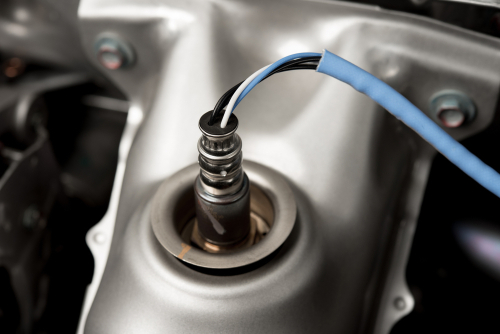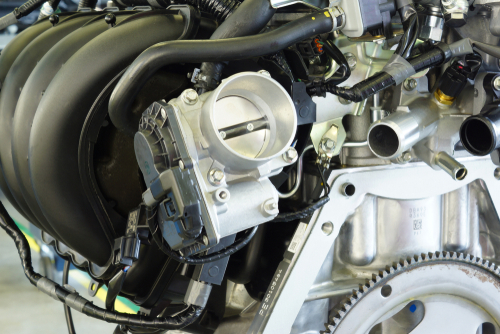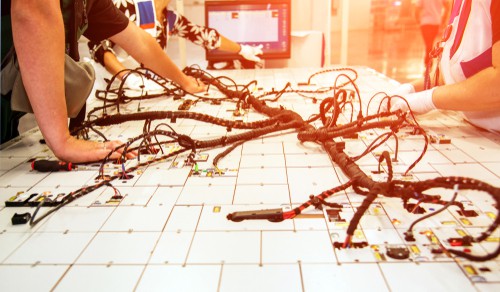Has your check engine light come on, revealing the mysterious P0032 code? Don’t worry, you’re not alone in this automotive adventure.
This code, which stands for “HO2S Heater Control Circuit High (Bank 1 Sensor 1),” might sound like a mouthful, but it’s actually a common issue that many drivers face.

The P0032 code indicates a problem with the heating element in your oxygen sensor, specifically the one located in Bank 1, Sensor 1 position.
This little gadget plays a crucial role in helping your engine run efficiently and keeping your emissions in check. When it’s not working properly, your vehicle might not perform at its best, and you could even fail an emissions test.
Don’t let this code drive you crazy! With a bit of knowledge and some detective work, you can get to the bottom of this issue.
Whether it’s a faulty sensor, a wiring problem, or something else entirely, understanding the P0032 code is your first step towards getting your vehicle back in tip-top shape.
So buckle up, and let’s diagnose this trouble code together!
Key Takeaways
- P0032 indicates a problem with the oxygen sensor’s heating element in Bank 1, Sensor 1.
- This code can affect your vehicle’s performance and emissions.
- Diagnosing and fixing P0032 may involve checking wiring, replacing the sensor, or addressing related issues.
Understanding the Code: P0032
P0032 is a diagnostic trouble code that can make your car act up. It’s related to your vehicle’s oxygen sensor, which plays a crucial role in engine performance and emissions control.
Definition and Implications
P0032 stands for HO2S Heater Control Circuit High (Bank 1 Sensor 1). In plain English, it means your car’s computer thinks there’s too much voltage in the heating circuit for the oxygen sensor.
This sensor is located on the engine bank containing cylinder #1. When this code pops up, your car might start running rough or guzzling more fuel than usual.
You might also notice that pesky “Check Engine” light glowing on your dashboard. It’s your car’s way of saying, “Hey, buddy, I need some attention!”
How the HO2S Works

The Heated Oxygen Sensor (HO2S) is like a tiny chemist in your exhaust system. It measures the amount of oxygen in your exhaust gases and helps your car’s computer adjust the fuel mixture for optimal performance.
The “heated” part is important because the sensor needs to be hot to work properly. That’s where the heater circuit comes in. It warms up the sensor quickly, so it can start doing its job even when your engine is cold.
When the P0032 code appears, it means this heating circuit is getting too much juice. Your car’s computer is scratching its metaphorical head, wondering why the voltage is higher than expected.
This can lead to inaccurate readings from the oxygen sensor, which in turn can throw off your engine’s fuel mixture. It’s like trying to bake a cake with a broken thermometer – the results might not be what you’re hoping for!
Potential Causes of P0032

When your car throws a P0032 code, it’s like your engine’s way of saying “Hey, something’s not right with my oxygen sensor heater!”
Common Electrical Issues
First things first, check your wiring and connections. You’d be surprised how often a loose wire or corroded connector is the culprit. It’s like when your TV remote stops working – sometimes it just needs fresh batteries!
Look for any signs of damage or wear in the wiring harness. A frayed wire can cause all sorts of mischief. Don’t forget to check your fuses too. A blown fuse is an easy fix, and you’ll feel like a pro when you solve it.
High resistance in the circuit can also trigger this code. It’s like trying to drink a thick milkshake through a tiny straw – the electrons just can’t flow properly.
Sensor and Heater Failures
Now, let’s talk about the star of the show – your oxygen sensor.
These little guys work hard, and sometimes they just wear out. If your sensor’s heater element decides to call it quits, you’ll see this P0032 code pop up.
A faulty oxygen sensor can’t heat up properly, which throws off your engine’s whole rhythm. It’s like trying to cook with a broken thermometer – you just can’t get the temperature right.
Sometimes, the problem lies in the heater control circuit itself. If it’s sending too much voltage to the sensor, you’ll get this high circuit code. It’s like overfeeding your goldfish – too much of a good thing can be bad!
Remember, diagnosing these issues often requires special tools. If you’re not comfortable poking around under the hood, it’s best to let a pro handle it. They’ve got the gadgets and know-how to pinpoint the problem quickly.
Diagnosing the Issue

Tracking down the culprit behind that pesky P0032 code can feel like finding a needle in a haystack. But don’t worry, you’ve got this!
Initial Steps
First things first, pop the hood and give your engine a once-over. Look for any obvious signs of damage or wear to the wiring near the oxygen sensor. Loose connections or frayed wires can be troublemakers.
Next, grab your trusty OBD-II scanner and pull up the freeze frame data. This will give you a snapshot of what was happening when the code was set. It’s like catching the culprit red-handed!
Don’t forget to check your vehicle’s service manual. It’s a goldmine of information specific to your ride. You might find some model-specific quirks that could save you hours of head-scratching.
Using Diagnostic Equipment
Time to break out the big guns! Your scan tool will be your best friend here.
Use it to monitor the oxygen sensor’s heater circuit voltage. If it’s higher than spec, you’ve found your smoking gun.
A multimeter can also come in handy. Check the resistance of the heater circuit. If it’s out of whack, you might be looking at a faulty sensor.
Remember, your PCM (that’s the brain of your car) is pretty smart. It might have logged additional codes that could provide more clues. Don’t ignore these breadcrumbs!
Lastly, if you’re feeling brave, you can use a test light to check for power at the oxygen sensor connector. Just be careful not to short anything out – we don’t want to add more problems to the mix!
Effective Repairs and Solutions

Got a P0032 code giving you headaches? Don’t worry, we’ve got your back. Let’s dive into some fixes that’ll have your ride purring like a kitten in no time.
Fixing Wiring and Connections
First things first, let’s check those wires. You’d be surprised how often a loose connection or frayed wire is the culprit.
Start by inspecting the wiring harness connected to your O2 sensor. Look for any signs of damage, corrosion, or loose connections.
If you spot any issues, it’s time to channel your inner electrician. Clean those corroded terminals with a wire brush, and make sure all connections are snug. For damaged wires, you might need to break out the soldering iron or invest in a new harness.
Don’t forget to check the fuse for the O2 sensor heater circuit. A blown fuse could be your ticket to P0032 town.
Oxygen Sensor Replacement
If your wiring looks pristine, it might be time to bid farewell to your old O2 sensor.
These little guys work hard and sometimes just wear out. Replacing the oxygen sensor on Bank 1, Sensor 1 is often the ticket to clearing that pesky P0032 code.
You’ll need a new sensor (make sure it’s the right one for your ride) and an O2 sensor socket. Locate the sensor, unplug it, and give it a twist. Out with the old, in with the new!
Remember to use anti-seize compound on the threads of the new sensor. This’ll make your future self thank you when it’s time for the next replacement. Once installed, clear that code and take your car for a spin. With any luck, you’ve just kicked P0032 to the curb!
Preventing Future P0032 Codes
Hey there, gearhead! Want to keep that pesky P0032 code from popping up again? Let’s talk about some preventative measures that’ll make your car happier than a pig in mud.
First things first, keep those oxygen sensors clean as a whistle. They’re like the nose of your engine, sniffing out the air-fuel mixture. A dirty sensor is about as useful as a screen door on a submarine.
Regular maintenance is key, folks.
Change your oil on time, and don’t skimp on the quality. Your engine will thank you by purring like a kitten.
Check your wiring harnesses more often than you check your social media.
Corroded or damaged wires can cause more trouble than a raccoon in a trash can.
Here’s a quick checklist to keep your engine running smoother than butter:
- Inspect fuel system components
- Clean the mass airflow sensor
- Replace the air filter
- Check for exhaust leaks
Remember, a healthy engine means better fuel efficiency. You’ll be passing gas stations like they’re going out of style!
Don’t forget about your catalytic converter. It’s working harder than a one-armed wallpaper hanger to keep your emissions in check. If it’s clogged, your oxygen sensors might throw a fit.
Lastly, if you’re driving a Nissan or any other make, always use high-quality replacement parts.
Cheap parts are like cheap shoes – they’ll leave you stranded when you least expect it.
Frequently Asked Questions
Dealing with a P0032 code can be tricky, but fear not! We’ve got some quirky tips and tricks to help you navigate this automotive conundrum. Let’s dive into some common questions that might pop up when you’re faced with this pesky problem.
What peculiar tricks can resolve a high voltage issue in the heater control circuit of the upstream oxygen sensor?
You might be surprised, but sometimes the simplest solutions work best.
Try cleaning the sensor connections with electrical contact cleaner. If that doesn’t do the trick, check for any loose or corroded wires. A bit of wiggling and jiggling might just solve your problem!
Is there a map to find the elusive bank 1 sensor 1, or do you need a treasure map?
No need for a compass or Indiana Jones-style adventures!
Bank 1 sensor 1 is typically located near the engine block on the exhaust manifold. In most cars, it’s the first sensor you’ll encounter after the exhaust manifold. Just follow the exhaust pipe, and you’ll strike gold!
What are the tell-tale signs that your vehicle might be throwing a code for a heater control circuit malfunction?
Your car might start acting like a moody teenager.
You could notice poor fuel economy, a rough idle, or even a check engine light that seems to wink at you. Don’t ignore these signs – your car is trying to tell you something!
Cruising with a Toyota and encountered a P0032 code – what’s your vehicle trying to tell you?
Your Toyota’s feeling chatty!
This code is its way of saying, “Hey, my oxygen sensor heater circuit is acting up!” It could be due to a faulty sensor, damaged wiring, or even a PCM issue. Time to put on your detective hat and start investigating!
Got a Dodge that’s acting up with a P0032 code, any unique quirks to look out for?
Dodge vehicles can be a bit dramatic when it comes to this code.
They might throw a tantrum in the form of decreased engine performance or even stalling. Check the fuse box first – sometimes a blown fuse is the culprit behind all this drama.
How does an average weekend mechanic tackle a P0032 code in a Jeep without turning it into a lawn ornament?
First, take a deep breath – your Jeep isn’t destined for yard art just yet!
Start by checking the wiring for any obvious damage.
If everything looks good, you might need to test the oxygen sensor with a multimeter.
Remember, patience is key – Rome wasn’t built in a day, and neither was your Jeep!
